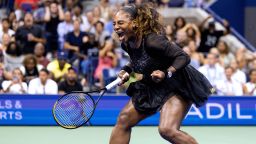Editor’s Note: Amy Bass (@bassab1) is professor of sport studies at Manhattanville College and the author of “One Goal: A Coach, a Team, and the Game That Brought a Divided Town Together” and “Not the Triumph but the Struggle: The 1968 Olympics and the Making of the Black Athlete,” among other titles. The views expressed here are solely hers. Read more opinion on CNN.
Listening to the roar that greeted Serena – please remember that icons need no last name – as she walked onto the court of Arthur Ashe Stadium Monday night at the US Open, it felt like even her opponent Danka Kovinic’s own mother might be rooting for the tennis legend as she made what many speculated would be her last appearance in a singles match…ever.

It is no wonder that her grand entrance, which felt more suited to a boxing ring than a tennis court, included a glittery train that swished behind her as she walked, an accessory that accentuated her royal status, a status that she gets, that she owns and that marks just how long her evolution – her word – has been, a far cry from the 17-old-year wunderkind with the white-beaded head of hair. Her five-year-old daughter emulated her style as she sat and took photos of her mother as she won 6-3, 6-3, surrounded by the kind of luminaries – Bill Clinton and Dr. Ruth, Lindsey Vonn and Spike Lee, Mike Tyson and Martina Navratilova – suited for a coronation.
Now the superstar, the GOAT, has not one but two matches ahead of her – the start of doubles play with sister Venus, and a face-off against world number 2 Anett Kontaveit on Wednesday, who joined the Serena bandwagon as well, rooting for her in her opening match and understanding well what kind of a spotlight she will have with Williams on the other side of the net.
Williams’s road to what so many considered to be her last show on the big stage involved little court time, with only a handful of matches played in the last year. Bookies gave her return to Flushing Meadows at the ripe old age of 40 terrible odds, and a post-game celebration of her career was planned whether she won or lost – indicating that those behind the scenes of the tournament assumed the latter.
Was the six-time US Open champion perfect? No. Her movement is nowhere near what it once was, almost ensuring Kovinic a point any time she was able to place the ball behind Williams. But across a career that includes almost every superlative possible, from the 23 grand slam titles (10 of which came after she turned 30) to the staggering 14-0 that she and her sister have posted in Grand Slam doubles finals together – a record untouched by anyone in any event, singles doubles, mixed, men’s, women’s – this we know: Serena Williams always comes to win, making any imperfections in her game that commentators want to point out almost beyond the point.
So, while so many billed this as her last hurrah, her swan song, her farewell – apocryphal, really, because of that doubles slot – Williams played it as something different: another chance to win. As her pace and power picked up across the first set, it was clear that the champion came to compete, and with each perfect toss into the air, and each powerful serve – topping 115 miles per hour – that slammed the ball back down to earth, it was clear that this was not, regardless of what the montage that accompanied her entrance implied, her last stand in a singles match.
Indeed, when it felt like she might be digging herself into a hole, that serve often got her out – powerful 115 mph aces, nine total, saving break points and allowing her to march forward, each one feeling more historic than the last. By the second set, she began to eat Kovinic’s second serve for lunch, breaking for a 3-2 advantage that convinced the crowd that she wasn’t a miracle – she was Serena.
Triple match point: done. Emotion poured out, accompanied by a happy dance. The ritual hand shake, and then the victory twirl, which her glittery black cocktail dress was made for. No matter what comes next, this was no swan song.
Up in the booth for ESPN sat John McEnroe, himself a legend of the men’s game, who once questioned Williams’s legacy within the sport, speculating that if she played the men’s circuit “she’d be like 700 in the world.” He later refused to apologize for the remark. Of course, men, as she so elegantly pointed out in the piece she penned for Vogue announcing her retirement, don’t have to choose between being an elite athlete and being a parent.
Yet even winning the Australian Open while eight weeks pregnant in 2017 was apparently not enough to quell the comparisons that successful women endure – on the court and off. Williams has been a critical power behind the change that has emerged in women’s sport in recent years. She once silenced critics of the catsuit she wore when she returned to the court after becoming a mother with details of the pulmonary embolism that almost ended her own life after giving birth. She is now putting front and center that after a career that included a cumulative six years at number one, she wants to make her daughter a big sister and pursue her other interests, particularly venture capitalism.
Get our free weekly newsletter
What, honestly, is there left for her, the most successful tennis player of all time (and that isn’t an argument to be made, but rather a premise) to do on the court?
Well, it appears she had at least one more thing to do at the end of a career that is, in her own word, “extraordinary”: She had to win a match that she was not supposed to win, giving us not just one more time to watch Serena, but one more time to watch that Serena. It should surprise no one that she, not us, not the media, not the bookies, will dictate when it is over. And it ain’t over – yet. Advantage Williams, indeed.




